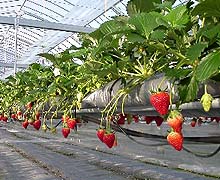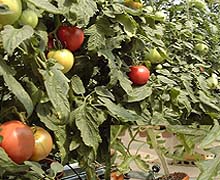Vegetable Crop Science
Vegetable Crop Science
Research on physiological and ecological issues of vegetable crops
Staff
 | Prof. Dr. Ken-ichiro YASUBA E-mail:ysbken (please add @okayama-u.ac.jp) Speciality: vegetable crop science |
Research Topics
‘Rakuchin’, a table top production system for strawberries
|
As strawberries grow and bear fruit just above ground, hard labor in a crouching position for picking and plant management have restricted large-scale production. We developed a new substrate culture system for strawberries ‘Rakuchin’ as one goal of our strawberry research. Now we are upgrading the system equipment and technical description, and also performing physiological strawberry research based on our production system. |  |
Qualified fruit production and development of blossom-end rot in tomato grown with root restriction
|
Tomato plants can grow with very small root volume when frequent fertigation is conducted in proportion to solar radiation. Adequately fertigated plants produce qualified but small fruits, and blossom-end rot (BER) often develops in young rapidly growing fruits. We are developing a productive tomato growing system with strict root-zone restriction and performing physiological research on BER development in relation to Ca nutrition. |  |
Development of environmental controlling techniques for protected horticulture
 Controlling the environment (air temperature, humidity, CO2 concentration, light environment) in greenhouses is important for the production of vegetables. Recently, the plant factory, in which integrated environmental control is carried out, has been attracting attention, and it is necessary to develop new environmental controlling technique continuously. We are developing environmental controlling technique using a Ubiquitous Environmental Controlling System (UECS), and a method for the utilization of information and communication technology for horticultural production.
Controlling the environment (air temperature, humidity, CO2 concentration, light environment) in greenhouses is important for the production of vegetables. Recently, the plant factory, in which integrated environmental control is carried out, has been attracting attention, and it is necessary to develop new environmental controlling technique continuously. We are developing environmental controlling technique using a Ubiquitous Environmental Controlling System (UECS), and a method for the utilization of information and communication technology for horticultural production.
Analysis of agricultural traits in Capsicum genetic bio-resource and its application for breeding
 Chili pepper (Capsicum genus) is a member of Solanaceae crops. Hot peppers are used as spice, and sweet peppers are consumed as vegetables. Both of them are important crops. Our group has collected various pepper accessions from all over the world, and possesses them as genetic bio-resources. Our bio-resources show diversity in pungency, fruits shapes, fruits color etc. We evaluate their agricultural traits to target their utilization for future pepper breeding. In addition, our main interest is variation of pungency in the Capsicum genus. We tried to identify the genetic factors controlling pungency.
Chili pepper (Capsicum genus) is a member of Solanaceae crops. Hot peppers are used as spice, and sweet peppers are consumed as vegetables. Both of them are important crops. Our group has collected various pepper accessions from all over the world, and possesses them as genetic bio-resources. Our bio-resources show diversity in pungency, fruits shapes, fruits color etc. We evaluate their agricultural traits to target their utilization for future pepper breeding. In addition, our main interest is variation of pungency in the Capsicum genus. We tried to identify the genetic factors controlling pungency.
Publications
・Establishment of an environmental measurement node using open source hardware. K. Yasuba, T. Hoshi, S. Kaneko, T. Higashide, H. Omori, A. Nakano, Agricultural Infrmation Research. 22. 247-255. 2013 (in Japanese with English abstract).
・The complete mitochondrial genome sequence of Brassica oleracea and analysis of coexisting mitotypes. Y. Tanaka, M. Tsuda, K. Yasumoto, T. Terachi, H. Yamagishi. Curr. Genet. in press.
・Analysis of non-pungency, aroma, and origin of a Capsicum chinense cultivar from a Caribbean island. S.Koeda, K. Sato, K.Tomi, Y.Tanaka, R.Takisawa, M.Hosokawa, M.Doi, T.Nakazaki, A.Kitagjima. J. Japan. Soc. Hort. Sci. 83. 214-221. (2014)